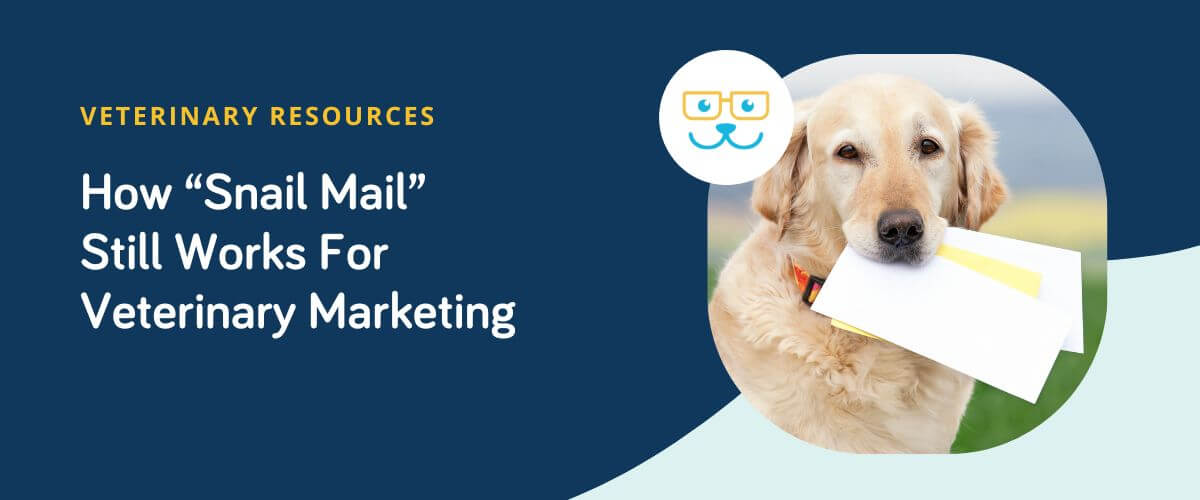How “Snail Mail” Still Works For Veterinary Marketing
A Note About This Blog Post From Our Team at GeniusVets! This post was written by one of our founders, Dr. Michele Drake—Owner of The Drake Center For Veterinary Care in Encinitas, CA. She is one of the highest-performing practice owners in the country, but that could perhaps make you skeptical. Why wouldn't Dr. Drake want to keep her trade secrets close to the vest? She has always been passionate about sharing the secrets to her success with other practice owners because she genuinely believes that each one of you can elevate one another and the veterinary field in general. So please read on and enjoy Dr. Drake's take on snail mail and why it's still a valid client contact method despite our very digital world.
...
Veterinary clients are online. They’re on their smartphones checking out websites, reviews, directories, and social media, so of course, that’s where you post your contact information, recommendations, behind-the-scenes snippets, and more. And while they’re on those phones, you can reach them via text and email with appointment and service reminders!
But what happens when a pet owner swipes away an email notification while watching a video? What happens when they don’t pick up your practice’s reminder text because they’re driving? Pretty frequently, they can forget to go back to those notifications later.
Sometimes, it takes a non-digital medium to capture the attention of local pet owners, whether it’s to reinforce what they see online or to rise above all of the buzz. The perfect complement to all your digital marketing efforts is surprisingly old school: postal “snail mail.”
Go Big When Reminder Postcards Go to Homes
When you choose larger size postcards, you have room to clearly print important information, such as complete service names and due dates. You can also clearly brand and personalize when you have more space, so, for instance, your logo won’t have to compete with a patient or breed photo. Finally, these larger sizes are more noticeable in potentially crowded mailboxes.

And remember, these mailings are meant to complement your other marketing efforts. If you’re promoting a blog on heartworms on your website and social channels, maybe heartworm info belongs on this month’s postcard, too. Do you have details online about an upcoming hospital event? Print a simple landing page address on your paper mailer where people can go for more information and RSVP. Looking to grow your Facebook, Instagram, or Pinterest followings? Let mailer recipients know your usernames. The key is to allow all of your marketing efforts to work together!
While your practice culture and mission will dictate precisely what you put on the card, the most important thing is to have a disciplined method of designing, printing, timing, and mailing these reminders.
Post Mail Veterinary Reminders Require Discipline
“Snail mail” will help your practice retain veterinary clients - as long as you implement it as part of a disciplined reminder system. Reminder mailings must go out consistently (meaning, for all upcoming and overdue services) and at a consistent cadence (with timing that allows enough notice to make appointments and bring pets in before overdue services lead to health dangers). A strategy that combines email, text, phone calls, AND postal reminders will lead to “appointment compliance increases and not to mention, customer loyalty.”
As an important aside, you must consider how forward booking works hand-in-hand with this reminder system. Discipline in a reminder system will naturally occur when you ensure that forward-booked appointments trigger removal from postal mailing campaigns aimed at bringing upcoming or overdue services to light. Whether your practice management software does so automatically or whether someone must devote time to do this manually, you need this to happen so that you don’t confuse your clients or give a negative impression of your practice’s record-keeping. They’ve already made appointments, and what they need is reminders for those appointments, not for the services that will be addressed.

And don’t forget your patients’ “siblings”! It is not uncommon for a dog to see the veterinarian regularly, while the cat in the same family rarely does. Or, a client may have begun a relationship with your practice via an appointment for one sick pet, and you’ll need to use previous records to determine when all family pets will be due for preventive services. Reminder mailings should ultimately include every pet from every client family. Again, you can maintain this standard through discipline.
Promotion, Motivation, and Education in the Mailbox
When you find out that your practice management software shows overdue services because pets have moved out of the area, this is an easy fix. If you know that a patient cannot or will not return to your practice, you can simply remove the reminder triggers. But, for many reasons, clients just don’t bring their pets to you on their preventive or chronic management schedule. Frustrating, but true - and nearly universal.
Post mail, again in conjunction with emails and texts, can help you reach these clients in ways that capture their attention and motivate them to get their pets up-to-date on veterinary services. How you do this will depend on your practice culture, but the bottom line is promotion. Now, before you bail on this article right here, remember that promotion is NOT the same as a sale or discount - we promise!
Sometimes, you can think of “promotion” as synonymous with “educational campaign.” For example, if you notice that a large portion of your patient base is overdue on rabies vaccines, you could design an eye-catching post mailer with a statistic. Think about how effective the vaccine is, the number of wildlife rabies cases in your community, or the likelihood of zoonotic transmission. Without being overly alarmist, you can also alert your clients to local laws governing rabies vaccines. Imagery should be bold but not graphic in nature. Written text should be exact but should avoid medical jargon. In this case, you would be educating local pet owners and/or applying a reasonable dose of fear-based pressure, NOT offering service discounts.

This is not to say that service discounts are inherently negative. This is when a strong sense of your practice culture and good communication of what this culture entails to your staff come into play. If your marketing strategy involves offering coupons, discounts, or special offers, physical mailers are prime materials for letting your clients know. For instance, your clients may be enticed to schedule appointments before a particular special offer expires. If you want to bring overdue patients in with an offer of $20 off or a complimentary nail trim, which fits into your practice’s general mission and personality, give it a try!
Mail that Builds Initial Relationships - and Looks Forward to Retention
At my practice, The Drake Center for Veterinary Care, we regularly obtain mailing lists of new homeowners in our service area. We reach out to those who have newly moved to our community to welcome them and, of course, to establish some brand awareness. This mailer is a full packet of information to introduce the practice, and we hand address the envelope for a personal touch. Perhaps most importantly, this packet includes an offer of $50 off their first visit to The Drake Center. On average, we get one or two of those offers redeemed each month, and total appointment costs easily help the mailers pay for themselves.
But what about recouping that $50 offer? And how does this new client acquisition initiative help with the Retention Stage of the Customer Journey?
Another significant component of this new homeowner packet is a refrigerator magnet. It’s simple, but it’s branded, and it’s useful. It goes in the middle of the kitchen, the heart of the home, which helps cement client bonds. As part of a mailed packet, Drake Center magnets help pet owners remember us and stay with us after using the initial discount.

If You’re Going to Get Personal, You Better Really Mean It
A word of caution: attempts at personal mailings that fall flat will end up in the recycling bin. I’ve received birthday cards from a dentist before, and on its face, this would seem like a cute idea. But when a birthday card is preprinted or stamped with smeared ink from “The Staff at ABC Business,” and when it does not even include your name, it is impersonal. It holds no value and does not motivate clients to return or bond to a business.

Your practice culture may call for mailed birthday cards to all patients or a specific cross-section. This could include the highest invoices, doggie daycare regulars, senior pets, or whichever grouping makes sense to your business. But if you’re going to move forward with a bonding initiative like this, make it special. Devote the staff and man-hours to creating truly personalized well wishes. This is something that your clients will appreciate.
Note that the same is true for sympathy cards after a pet has passed. You can decide whether the entire staff, just a doctor or just the staff present at the final appointment, will sign a card to a family who has lost a pet. But the operative word is “sign.” Don’t just stamp or preprint these sensitive mailers. From a business perspective, this family may not have other pets, and you don’t want to leave a bad taste in their mouth for when and if they decide to bring another pet into the family later. But more importantly, on a human level, this is a space for sympathy and empathy, and real signatures convey authenticity to a family working through grief.
Multiple touchpoints give your practice various opportunities to connect with your clients and encourage them to return for routine and chronic care appointments. Physical mailers and email complement each other because they are two different media for delivering the same information. And the more ways you can tell clients what you recommend, the more likely they are to follow through for their pets’ best health care.
You can find a touchpoint to connect with other veterinary marketing pros on Facebook! Join the GeniusVets Veterinary Marketing Professionals Group to share ideas and tips and celebrate your marketing victories! Also, be sure to sign up for a GeniusVets demo to learn more about expert hiring strategies as well as improving your bottom line.

